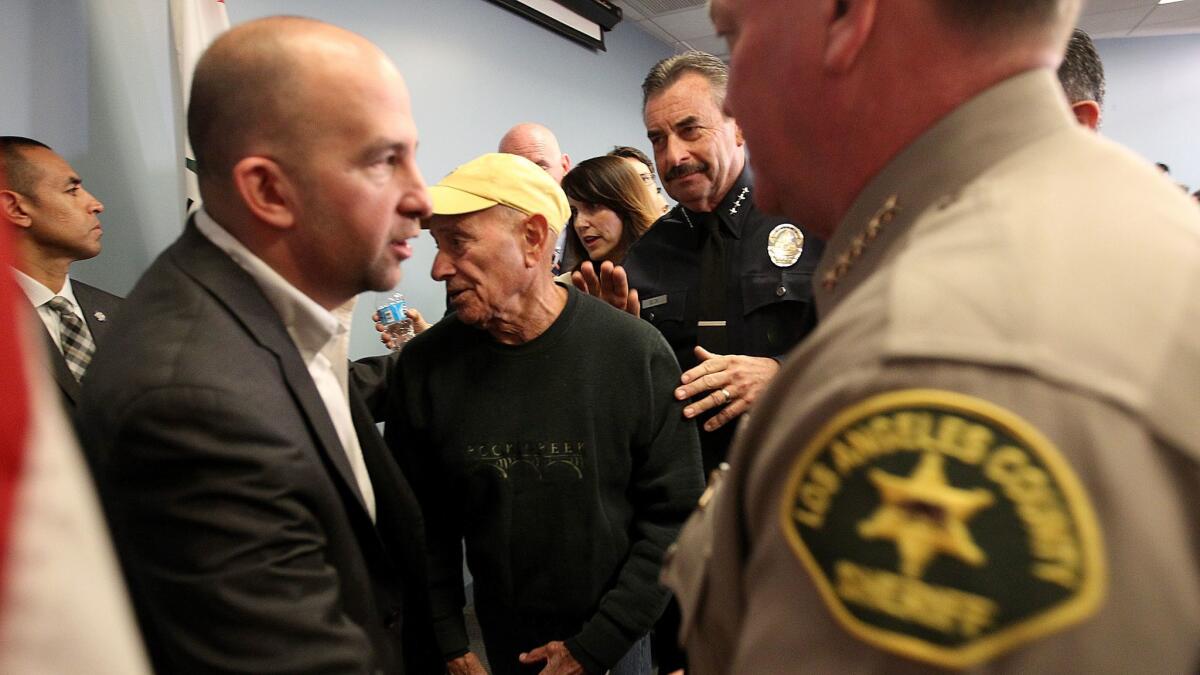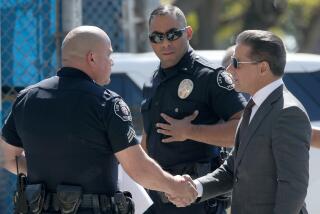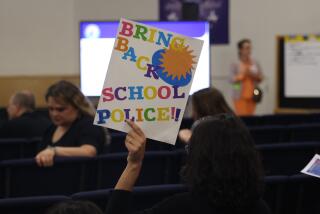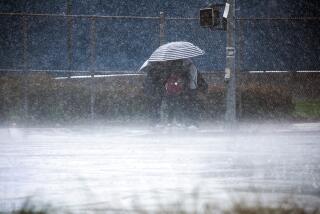Report on L.A. school shutdown shows confusion over who was in charge, technology shortcomings

An internal report on last year’s unprecedented one-day shutdown of Los Angeles schools due to a terrorist threat reveals a confused chain of command among school district and city officials that hampered their ability to quickly and decisively evaluate the risk.
In the end, district officials made a cautious decision regarding the threat, which turned out to be a hoax, as was suspected very early on.
New York City schools received the same emailed threat and remained open.
Once the decision to close L.A.’s schools was made, the process of shutting down the nation’s second-largest school system, which affected the daily routines of more than a million people, unfolded with remarkable smoothness and calm: School buses turned around or never left the garage. Employees went home or stayed home. Students and parents made contingency plans. The media and officials got out the word. Officers walked through nearly 1,000 campuses.
But part of this success was due to the fact that no real emergency existed. The report acknowledges serious logistical problems outside of public view that could have mattered in an actual crisis.
The report, released in response to a Los Angeles Times public records request, affirms that law enforcement and district officials acted quickly to confront the threat, bringing impressive resources to bear. But outside law enforcement agencies also stepped aside over the question of whether schools should be closed, leaving the decision to school officials who lacked any training to evaluate the danger.
The district also was in the middle of a leadership transition, which hampered the decision-making. L.A. schools Supt. Ramon Cortines was on the verge of retirement and had turned over day-to-day control to his second-in-command, Michelle King (who, about a month later, would be named his successor). This unsettled situation crucially affected how events played out.
Cortines was not even notified of the threat until 4:55 a.m., nearly seven hours after it was known, at which point he had to make an instant call just before the start of the school day.
“In hindsight, it would have been prudent to brief other key district executive staff and the superintendent of schools in the early stages of the investigation to better allow for administrative and operational considerations,” the report concludes in something of an understatement.
The report does not state when King first was notified or explain what, if any, attempts were made to reach her. The language of the report relies repeatedly on passive-voice construction, making it impossible to determine exactly who made important decisions within L.A. Unified. The Times has pieced together additional details through interviews with key players.
The drama began at 10:01 p.m. on Monday, Dec. 14, when school board President Steve Zimmer received the emailed threat. He happened to be on his computer at the time, and he did not know that the threat had also been sent to other past and current board members and to the New York City school system.
“I am emailing you to inform you of the happenings on Tuesday, 12/15/15,” the email began. “Something big is going down. Something very big. It will make national headlines. Perhaps, even international ones.”
The email then spoke of a desire to avenge bullying suffered for being a Muslim. The sender vowed to detonate pressure-cooker bombs hidden in backpacks, release nerve gas at lunchtime and launch assaults by more than 30 people armed with “Kalashnikov rifles, Glock 18 machine pistols, and multiple handheld grenades.”
At 10:17 p.m., Zimmer notified school police Chief Steven K. Zipperman. Zipperman notified the Los Angeles Police Department 11 minutes later. By 10:41 p.m., LAPD’s major crimes unit and the FBI were involved.
Early on, “the objective was to identify the sender and source before the beginning of the school day,” the report states. “While the threat ‘as a whole’ appeared unlikely, portions of the threat were concerning.” Posturing aside, there was fear that a “lone wolf” was out there, intent on doing harm days after the terror attack that killed 14 people in San Bernardino.
By 2:30 a.m., computer technicians and law enforcement investigators determined that the threat came from an overseas server, apparently in Germany, although it could have been routed there from someone in the United States seeking to cover their tracks. If so, the strategy apparently worked because the FBI still has made no arrests.
Even though the report avoids the topic, it is clear based on interviews that Zimmer and Zipperman played instrumental roles, including in the delay in notifying Cortines.
“For me, the urgency was to get it into the hands of law enforcement and certainly to be there to convey my urgency and concern,” Zimmer told The Times. “Until their determination was that we were going to have to make a decision about shutting down all the schools, I did not think we had to wake the superintendent up in the middle of the night.”
Zimmer also acknowledged his limitations in evaluating the situation: “This type of threat I have no ability to assess. I had no expertise to offer whatsoever and no ability to really make a determination of do you wake up the superintendent.”
King first appears in the district’s timeline as part of a conference call with Zipperman and Zimmer at 4:41 a.m., although it is likely she already had been notified. King declined to be interviewed about the incident after it occurred, and a district representative said she was not immediately available Friday.
“Based on the conference call, it was decided that in the best interest of the safety of the students and staff of the LAUSD, all school sites should be checked prior to any students or staff entering,” the report reads. “Because of the scope and magnitude of the final recommendation to check all schools, a districtwide ‘shutdown’ was the only option.”
At this point, police agencies were not willing to completely discredit the threat or tell the district what to do. Zimmer said he began to realize, along with King and Zipperman, that the decision was going to fall to the district. King had the authority to cancel school, but the triumvirate decided to defer to Cortines.
The situation unfolded differently in New York City, where ultimate authority rested with the mayor, who compelled his police commissioner, William J. Bratton, to make a decision based on the chief’s expertise. Bratton decided no school shutdown was necessary.
In L.A., Cortines awoke to a conference call that included Zimmer, King, Zipperman and LAPD Asst. Chief Earl Paysinger, according to interviews.
Paysinger offered no advice on what to do, said Cortines. His role, apparently, was simply to offer support for what Cortines decided.
“They talked about involvement of the FBI,” said Cortines. “And they said, ‘This is still under investigation.’ Those are the words they used with me.”
“Time was against me,” Cortines said. “The starting of the buses were against me. I knew I had to do something quickly if I was going to do something.”
There also was peril in excessive caution. A clumsy effort to close schools would be embarrassing, and the district stood to lose $30 million for the lost day of student attendance. (The state later waived that penalty.)
Over the course of the day, the usually dapper Cortines, in sneakers and a yellow cap, became the face of steady leadership, backed literally and figuratively by a phalanx of city and law enforcement officials.
But things were less smooth than they appeared. Although L.A. Unified has been praised for its rapid responses to crises, it wasn’t fully prepared to shut down the entire system.
“The [school police] lacked an adequate standing response plan,” the report states.
Technical problems also limited the scope of the automated messages that went out. Cafeteria staff reported to their assignments. The district could not track the locations of its 1,300 school buses.
At the emergency center, “responders experienced difficulty logging into various district systems,” which were slow and suffered from “intermittently lost connections,” the report states. Too many people, eager to help, flooded the command center.
“Some computers crashed, some computers ran slowly, conference calling failed to work, and only one-third of the people” in the emergency center had access to computers, the report said.
District staff has addressed some of the problems and is looking into funding for other fixes, according to the partially redacted report, which was dated Oct. 4 and prepared by Zipperman and Associate Supt. Earl R. Perkins.
After the all-clear notice was given, after the emergency center had shut down, one more problem emerged late that evening. Milk and bread deliveries for the next day had never been made to cafeterias on the shutdown day. These deliveries usually happen in daylight hours for safety reasons.
A weary police force reassembled and escorted food trucks to their destinations. The following morning, when students returned to school, their breakfast was waiting for them.
Twitter: @howardblume
MORE ON EDUCATION
Supt. Michelle King’s strategic plan for LAUSD is chock-full of edu-speak, but short on specifics
UPDATES:
2:58 p.m.: This article was updated to add the potential cost of the school-district shutdown and to identify who prepared the report.
This article was originally published at 2:05 p.m.
More to Read
Sign up for Essential California
The most important California stories and recommendations in your inbox every morning.
You may occasionally receive promotional content from the Los Angeles Times.











